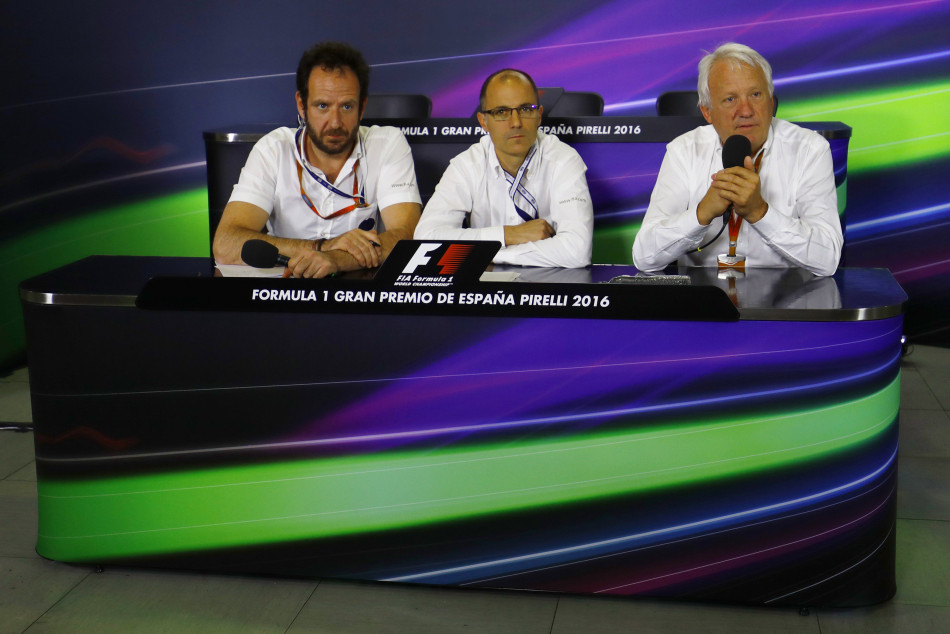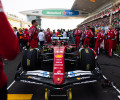F1 - 2016 Spanish Grand Prix - Discovering 2017 engine rules

OPENING REMARKS
FL: You heard that we made some decisions for ’17, ’18 and onwards for the power unit, that we call the power unit package, and this is just to explain how it works.
This was started in November last year and we had a mandate from the Strategy Group, with four pillars. The first one was reduction in price for the teams. The second one was obligation to supply. Then third one was help performance convergence, and the fourth one was to improve the sound. So these were the four pillars we worked on.
We had extensive work with the power unit manufacturers to try to achieve this. As always, we are not in a perfect world, so we achieved what we could achieve, but I honestly think it is a very good achievement.
So, I’ll explain you what is inside.
For the reduction in price for the teams, we first worked to reduce the cost, because we cannot ask the power unit manufacturers to reduce price without reducing cost. So to reduce the cost, firstly in ’17 we will go down to four power units per driver per season, instead of five today, whatever the number of grands prix. And in ’18 we will go down – and this is a big task for them – we will go down to three ICE, plus turbo, plus MGU-H and only two energy stores, control electronics and MGU-K. So it’s nearly 50% less parts, so it should reduce the cost by a nice amount.
We will also have standard sensors. This is a small part of the reduction but it is a bit of a reduction.
In addition to this we will have a discount for the price and there is an engagement from the power unit manufacturers to decrease by €1 million in ’17 compared to ’16 and by €4 million compared to ’16 from ’18 and onwards. So it gives discount for all the customer teams of around €28m per year, which is not something negligible I think.
For the obligation to supply: the idea was to have no teams that is not able to have access to a power unit. This was a big part of the discussion because we also don’t want people to be able to play with that and to change from one power unit to another from one year to another in order to have the best one. So there is a quite complex system in place, but the basic [premise] is that if you are a team with no offer, so nobody is offering you a power unit, you can ask the FIA to have one and there is a system of ballots. So we will take the power unit that has the smallest number of customers. If there is only one, this will be the one that will be required to give the power unit. If there is more than one there will be a ballot between the two to decide which one will supply, and there is a low price of €12m from ’18 for this supply.
The third pillar was to help performance convergence. So, to do that the first big thing that people thought was important is to have stability in the regulations.
There was a lot of discussion of changing completely the regulations, going back to normally aspirated engines, no hybrid. Firstly, nobody wanted that because the trend of the world is to go hybrid and to go low consumption.
But also they thought if there is a big change there will be a redistribution of the cards and there could be a big difference in performance between the power unit manufacturers, so they said stability of regulations would help a lot. So this is the first tool for convergence.
Then we free the tokens, because the ones that are a bit behind wanted no limitation of development to try to recover. We also put limits on some performance related dimensions. This is a bit technical and you all have the regulations but for example we put limits on the crankshaft dimensions, on the weights of some parts, so we are sure that there are limits on the development on these items. These limits were put where the best one is today, so that people know the target and also allow us to stop the best ones to develop more, to go lighter or smaller, so that we put something like a bit of a barrier to development.
In addition to this we put limits on the boost temperature, so they cannot develop too much their cooling and also a bit of packaging on the energy store and control electronics to avoid having to redo all the energy store to help the chassis performance.
Finally, this is an important point, but a short one – to improve the sound. There is a perception that the sound is not enough, and we have had very good results with what we call a ‘sound generator’, which is not fake, but it is not purely natural, let’s say, but that would really increase the intensity and the quality of the engine sound.
So that’s all I wanted to introduce, so if you have any questions, please don’t hesitate.
QUESTIONS FROM THE FLOOR
Q: In terms of the restrictions on dimension of various parts, I understand that some of that is to do with the hybrid system, including the energy store. Given that these engines were introduced in the first place to have parity with road car technical development, is that not restricting an area that would benefit road car development, in which case, why would you do it?
FL: For example, for the energy store, as you said, we are limiting the packaging in Formula One. I honestly don’t think you are limiting the global development for road cars. We are far ahead of road cars. They can work on the cells but the integration of the thing must be within certain limits to not go too far in Formula One. So it’s really only impacting Formula One. I don’t think it’s impacting all the rest.
Q: Is there going to be any change in the fuel amount, the 100 kilos. Has that changed?
FL: This is actually not part of the package but effectively it will go up by five kilos just in relationship with the new aero or chassis regulations, because we have cars that will be going much faster with much more full load so naturally the consumption will go up, but it is not at all linked to the package.
Q: Will the fuel regulation go up in time for the faster cars? Will you have that regulation introduced, even if it’s not part of this package?
FL: It was not part of the package but it was already voted and it’s already in the regulations for 2017. It’s 105 kilos.
Q: Fabrice, when you do the power convergence, how are you going to ensure that whoever your benchmark is is actually not sand-bagging at the time to be artificially low, so that you can ensure that you have there actual performance to ensure that they don’t gain an advantage after the convergence date?
FL: So clearly the package is to help convergence. We are not mandating convergence; there is no prescribed convergence. So we just put measure that should help convergence.
Naturally the convergence will come with the stability of regulation and we try to speed up the convergence by having these measures but there is no prescribed convergence.
Q: What’s the timeframe for sorting this convergence out, because they have talked about 0.3s per lap around Barcelona. When would expect that to be in place and what if it’s not? What if one of the manufacturers has found something and is suddenly 1.0s clear?
FL: So this figure of 0.3s is apparently something that went in the media. There is nothing prescribed, as I said, but we will measure it at the beginning of each season and if it is considered to be not at the level that we expect to be, we will come back to the Strategy Group and just report, and then what will happen will be a decision of the Strategy Group, according to the F1 governance we have today.
Q: With regards to the guarantee of supply, whilst it’s obviously in the regulations have you met any resistance from McLaren because Ron Dennis has made it quite clear in the past months that he wants to retain Honda as a sole supplier for his team, without them supplying engines elsewhere?
FL: For sure, it is not linked to McLaren, it is linked to every team. These negotiations were not easy but I think everybody understands for the sake of Formula One we need this to be implemented. So there is in the text some protection for newcomers and I think that’s what you heard about Honda, when they were really new they would struggle to supply. I think everybody is happy to implement the text.
Q: Can you explain how this sound generator is working, on what basis it is working, because you said it’s not 100% natural, but it’s not fake, so how is it working?
FL: It’s a bit early to say. It’s really under development. But we are using the energy on the exhaust, even if it is not very high, because we recover a lot, to increase it. To go into pure detail now I think it’s a bit too early. I’m sorry.
Q: Just to go back to the subject of McLaren and the contract that Ron says he’s got with exclusivity with Honda, does that mean we can say for certain that the new rules go over that contract now and they will be forced to do what the FIA says?
FL: Honestly, I don’t think I can answer this one, it’s really a private matter, I’m sorry.
Q: At the moment we’ve got, say, take Ferrari, they supply a different spec of engine to Toro Rosso. Is there any plans to address that going forwards to stop that happening?
FL: It is already in the regulations. It is a TD for this year and a regulation for ’17 if I am correct. It is clearly said that this is not possible. If you want more detail I have the regulation here. Clearly you must have the same spec between teams and you must introduce the updates – because we have in-season tokens from ’16, again ’17, you must introduce this update to your customer teams in, let’s say, a timely manner. So, for example, if you have your update today because you have a new engine, the next time you have a new engine on your customer team it must have the updates. This is already in the regulations for ’17 and regulated by a TD for this year.
Q: Contractually that has not been a problem?
FL: Not at all, as far as I know. There is a provision, if you ask the FIA, like for Toro Rosso, you can have this provision, but with the consent of the FIA, to have a previously homologated spec.
Q: The target cost price for the customer engines when you started was €12million. If you take €4million off what some of the manufacturers are charging at the moment, you come to a number that’s a long way up from €12million – apparently. So, how can you explain that disconnect?
FL: I think the good word is ‘apparently’ – because with the figures I have, I think we are not far. Even, very close.
Q: The original announcement mentioned a constraint on boost pressure for 2017 and 2018…
FL: Temperature. It’s a limit on temperature of boost, not pressure.
Q: Can you go into more detail of how that will work?
FL: The limitation is on boost temperature, so it is for the cooling. Pressure, we don’t touch it because it really at the core. We have a limitation on fuel flow and the boost pressure is free.
Q: Perhaps Charlie can answer this one. Looking at 2018 and the cutback to two control electronics, two energy stores and so on, isn’t that a bit extreme? Bearing in mind how unpopular grid penalties are with the public and so on, are you pushing the manufacturers a bit too much for them to cope with that?
Charlie WHITING: I don’t think so. I think we’ve already got the situation, as you know, where, if they go over the allocated maximum, then they can’t go any further back than the back of the grid. We had all those silly grid penalties before, where you had 50 grid place penalties, plus a drive-through, a stop go and all those sorts of things, which we stopped. So you can’t go any worse than the back of the grid, and that will only happen once when the new parts are introduced. But judging by the conversations I’ve heard, they all think its completely doable – so there really shouldn’t be any trouble.
Q: Charlie, the entire engine controversy has stretched on, in some instances from 2010, these regulations are going to be in until 2020 so the controversy’s lasted twice as long as what the regulation still has to run. What lessons have been learned in terms of framing regulations for the future over pricing, availability, convergence etcetera?
CW: That’s quite an expansive question. I’m not sure that there’s beem that much controversy, if I’m really honest but I think the one thing that we could learn from the introduction of the current power units would be that we could have a better consultation process prior to doing the regulations. I think we could have done a slightly better job on that in the beginning – but we live and learn and we’ll move on. Now the regulations are becoming very stable and I think, as expected, the power in converging naturally – but I think the measures that Fabrice outlined are going to improve the situation more. I think it will become very stable quite soon.
Q: In the regulations a May 6th date was put down for manufacturers to notify about intention to supply for next season but as far as you’re concerned is any team left at the moment without any option for engines next year?
FL: The deadline was the sixth of May to say they will commit to supply a team. This is done. The deadline to announce the list of teams they supply is the 15th of May. So we are two days early. Sorry.
Q: Does the obligation to supply contain any financial terms that should be executed by the power unit manufacturer for the team in need of that supply in question?
FL: There is a minimum price in this obligation to supply, which is not secret, it is in the regulation. It is €12million. When there is an obligation to supply, you have to protect the supplier because if I am a team and I know this guy is obliged to supply I would ask for a free supply. This minimum is therefore also some sort of a maximum.
Q: The limits you set for a crankshaft or whatever of materials. You said you looked at the dimensions from the current leader of the power unit – but is there anything that is forbidden which they have now in the power unit?
FL: No, we put limitations that are all in line with what exists and are in line to the best or the minimum. If we put a minimum dimension we put it just at the level of the minimum of the four. This is also true for materials limitations.
Q: When you’ve talked about a potential ballot needed to pick if there are two manufacturers that have to supply a team and it goes to ballot, what process is that? Is it pulling names out of a hat? Is it tossing a coin?
FL: The actual process at this level I don’t know, but there is a ballot clearly. Who is taking “the hat”, I don’t know.
Q: Can I just clarify something on this €12million figure. So let’s say, for example, Red Bull don’t have an engine contract for next year yet – but if they had a Renault engine next year, as they do this year, are you saying it would cost them €12million ?
FL: No. Because next year it is not €12million, it is minus €1million.
Q: Charlie, just getting back to your point on the limitation of components as we go through the years. This is year three of the power unit now, when you would expect reliability to have really come to the fore. We’re in race five, Lewis is already on his fourth MGU-H this race weekend. Are you quite confident, and do you have the guarantees from the teams, that they feel as we go into ’17 and ’18 they will be able to meet the impositions that have been set on the components.
CW: I’m confident because the power unit manufacturers are confident and they’ve agreed to these figures. So I doubt they would have agreed if they were extremely concerned about it. I think what we’ve seen this year has been an aberration. I think the two previous years we haven’t seen anything like that from Mercedes, which is quite a surprise really.
Q: Fabrice, Charlie, as far as I understand it, the obligation to supply covers existing teams – however if a new team should come into Formula One, it has to prove as part of the entry process that it has an engine. So at what stage would it kick in for a new team wishing to come in, that it must be obliged to get an engine?
FL: A new team is taken into account in the process, yes.
They can insist on an engine?
FL: Yes
Q: If I understand well, you said that you are going to check the difference between the performance of the different engines at the beginning of the season and if there is over the expectations, the three per cent for example you will report to the Strategy Group, is that right? If there is someone that is over that expectation, what will be the next step? Will there be a modification on the regulations that year? Is it for the following year? How will you react?
FL: We will report to the Strategy Group as I said, and the action is a decision of the Strategy Group. We will check this in the first three races which is a timing that is before the deadline to make a change at the majority for the following year. So we would be able – the Strategy Group, the Commission, the governance – should be able to do a change for the following year.
Q: Assessing the power differences between the engine manufacturers, what are you looking into? Are you looking into lap times from different teams, customer teams, are you looking into torque of the engines? What are you looking into?
FL: This is going to be a bit technical so forgive me if I am not clear. We have a process agreed with the power unit manufacturers. So we don’t look at lap times, we have tools to simulate everything so we can calculate the performance of the power unit itself on each car and we transform this in a power index. You have this hybrid system and an engine and you cannot only talk about horsepower, so it is translated into a power index. We check every car, every lap of these first three races. We take the best of each power unit for each race and each PU manufacturer, then we do the average over the three races. This should give a power index of performance for each power unit manufacturer. This is an index. Then we have a translation of this index into lap time on the Barcelona lap.
Q: Purely theoretical question. Let’s say a team running a 2015 engine this year would like the chance to have a current engine next year, and asks for a ballot. If he wins the ballot he gets a current engine for next year – maybe a Mercedes or a Ferrari – when can he ask for a ballot and when can this ballot be organised?
FL: The system is quite clear. The 15th of May, FIA should have a letter from the power unit manufacturers saying which contracts they have in place. If a team has no contract at all nor options, then the FIA will try to contact power unit manufacturers to try to solve the issue. If there is no contract yet at the deadline, which is the 1st of June, then we will organise this process which will be the ballot.

 Facebook
Facebook Twitter
Twitter






